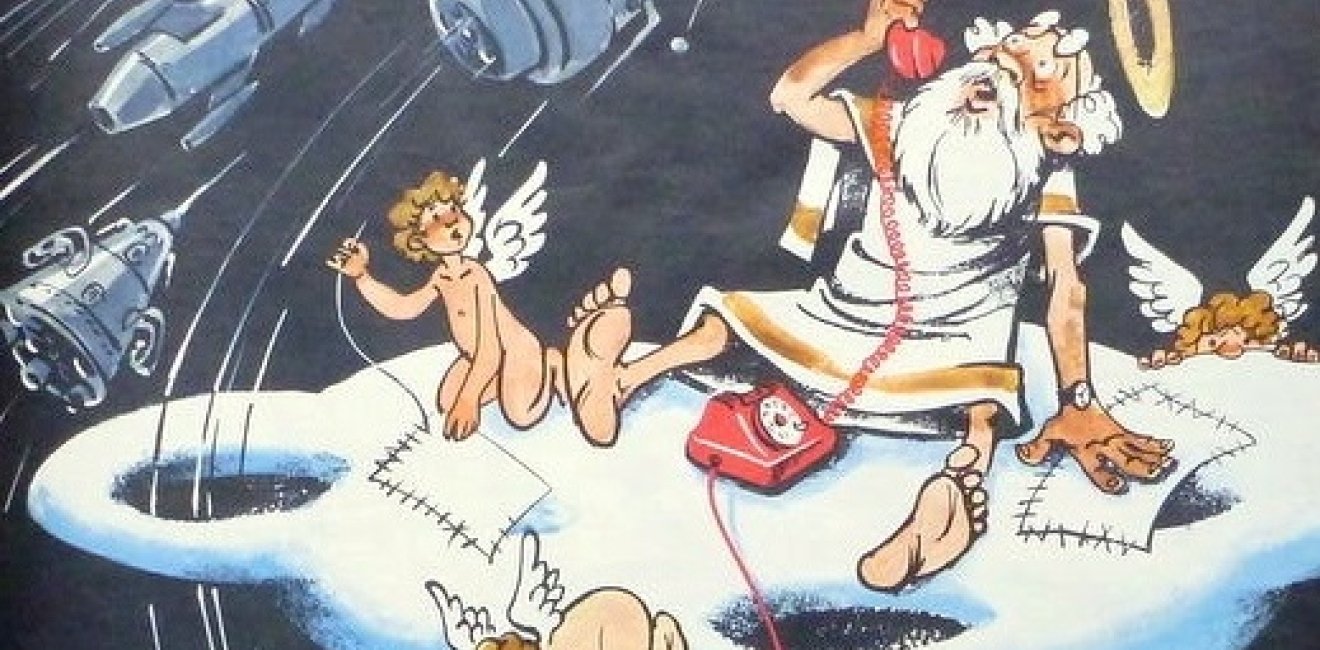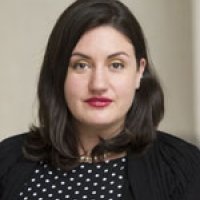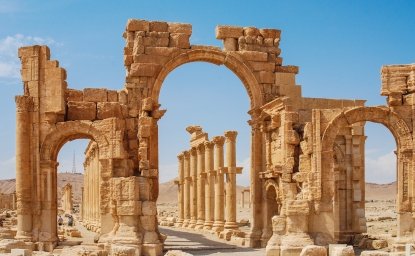In continuation of our alumni interview series, we talked with Title VIII-supported Research Scholar Victoria Smolkin-Rothrock to hear her reflections on her fellowship. Dr. Smolkin-Rothrock, Assistant Professor of Russian History at Wesleyan University, is writing a book about the confrontation between scientific atheism and lived religion in the Soviet Union. See the discussion below on religious policy and atheism throughout Soviet history.
Malinkin: Tell us a little bit about the phrase from your project title "a sacred space is never empty” — what is the story behind it, and what does it mean in the context of your research?
Smolkin-Rothrock: The phrase is from the Russian proverb, which in Russian is "Свято место пусто не бывает." It is usually translated into English as "nature abhors a vacuum,” which is close, but does not convey the sacred component, the “свято” part in Russian. I altered it to emphasize that. I wanted to express this crisis of meaning in the Soviet system. The people who worked on this professionally in the Academy of Social Sciences, produced this ideology, and thought about it — they were aware of that vacuum, especially after Stalin's death. There really wasn't a question of a values vacuum before Stalin died. They had the revolution, and a sense that they were building a new world, and they had a narrative. After Stalin died, however, the question arose of the moral foundations of the project. A sort-of cost-benefit analysis began in the country, and I saw the “sacred space” expression come up during Khrushchev’s time.
How was it used?
The phrase was used in that context by someone at an ideological commission in June 1963 to discuss what ideology would be going forward. One of the writers there, Vladimir Tendriakov, wrote village prose novels that had an anti-religious component, which was unusual because village prose novels were usually very sentimental about religiosity. In his speech he argued that the Soviet state had to address spiritual and ethical concerns because if it didn’t, they would be dealt with by religion “because a sacred space is never empty." They were fighting for the Soviet soul. In their vision there was a space in which Soviet society and each individual Soviet citizen held a secret commitment. The question was — where would this commitment land?
What role did Khruschchev play in trying to win this commitment?
Khrushchev’s big project was re-narrating communist ideology after Stalin. After his “secret speech” in 1956, he initiated a series of ideological commissions, which were charged with studying things like public opinion and the state of domestic affairs and social life. In the course of this work, they devoted a good amount of their time to the question of ideology, and the positive foundation of Soviet communism after Stalin. Would de-Stalinization leave an "empty space," where Stalinism had been, or was there a positive meaning of Soviet communism that had to be restored? Rhetorically, the answer in the late 1950s was to go back to “authentic Leninism.” In my area of research, the problem that had to be solved was religion. It had been 40 years since the revolution, and socialism had been built, so why was religion still around? Religion had been treated as a political enemy under Lenin and Stalin, and addressed through scientific enlightenment campaigns under Khrushchev. So we’ve neutralized the Church and proven there is no God… But religion was still around, the ideologists came to see, because it was something greater than institutions and ideology. It's about psychology, emotions, tradition, community, etc. In this context they began to address the spiritual components of religion.
Who were the people on the commission? Sociologists, other social scientists?
It's interesting you brought up sociologists because this was a re-birth of Soviet sociology. There of course had been Russian and early Soviet sociology, but then it disappeared because sociology was considered bourgeois. In fact, up until the late 1950s, when you used the word "sociology," it always had the adjective "bourgeois" with it. Marxism-Leninism was their sociology — “we already have sociology!” But this all changed in the 1950s. This was partly because they had to deal with all these social, economic, and political problems of modernization and destalinization, and they needed data. So the state really became much more modern. It began to look like a technocratic bureaucracy, gathering and studying information. Some of the people on the commission were proto-sociologists. Most of them were in the party apparatus — cadres in the Central Committee propaganda department, people from the Academy of Sciences, and other advisors and invited speakers.
Any notable participants?
One of the speakers was the cosmonaut German Titov, who was second only to Gagarin. Titov, unlike Gagarin, embraced his role as an “enlightenment icon,” and, for example, went to the Seattle World Fair and said "I went to space, and there is no God." When he spoke at the ideological commission he said "People ask us, cosmonauts, what we think about religion. On the one hand, we can of course say that there is no God. On the other hand, we don't know what to answer people because we are completely illiterate in religion. We've never read a Bible." He urged the commission to give Bibles to cosmonauts. Another interesting character was Alexander Osipov. He was a theologian at the Leningrad Theologian Academy until he publicly broke with the Russian Orthodox Church through a letter to in Pravda in 1959. It seems likely that his defection was stage-managed by the KGB, but he was also a clearly convinced atheist. He became one of the most well-known public atheists and was paraded around the country on lecture tours, television and radio shows. His value was that he was someone from the inside saying "I know the Bible better than anyone, and there is no God."
Tell us more about atheism in this period – was it the main option for filling the “sacred space”?
If we are going to put atheism in that space, what is atheism? In the Soviet version, they said, “bourgeois atheism is a sort of existential atheism.” It says there is no God and leaves you in a black void of despair. However, Soviet atheism is, or at least should be, a positive atheism. It says there is no God, however it offers you something in its place, so that you have something on the other side of the "death of God." The main message was “Our atheism is positive.” However, what did that actually mean? And nobody had an answer. There was no theology that went along with the Marxist revolution. In fact, the "founding fathers" of Soviet communism did not think a great deal about religion, because it was supposed to go away by itself. And when it didn't go away, they had to think about it. But they did not have any ready-made theory to apply. They referred back to statements by Marx and Lenin, of course, but those were not enough to make sense of the situation they were facing in the 1960s.
Was there a period when atheism was really popular in the Soviet Union? And was it more successful in some places in the Soviet Union than others?
It depends on how you define success. For example, the ritual campaign in Leningrad gained momentum in part because it had support of the Komsomol, which was very interested in weddings. Their position was “why do we have to go to these miserable ZAGS offices to sign the papers? Why can't we have a wedding?” It was also a generational issue, as you had post-war youth growing up, for whom it was not entirely clear why they still had to live according to the ascetic principles of their parents. It's hard to say whether it was success for atheism, even though it was very connected to the atheist project. It wasn’t articulated as an outrage like "we don't have atheist rituals!" There was recognition of not being able to get married in a church, since it was against Komsomol statutes, but still wanting to be able to get married and have a meaningful celebration. And there was recognition that spaces were needed as well as wedding dresses. There were all sorts of debates — "should we wear wedding rings or not? What is getting married supposed to look like?" One thing that was clear was that it was not supposed to look like in the 1920s – no one was going to get married in their Red Army outfits. Instead, there was a new consumerist culture. It gives you a glimpse of the mentality of the time.
There are so many sub-periods in Soviet history…
That's a very important part of what I was trying to do because there is a storyline of Soviet history that goes: the Revolution, the Civil War, NEP, the Great Break, the 5-year plans, the Terror, and then the end of the war and Stalinism. But there was a long period of time, 1953-1991, without Stalin. There were a couple of generations who had to live in that world, and Stalin was not their reference point. That's what I was trying to see, how was the story told after the official narrative receded. Some people have already done a lot of that work. My research is more about the production of ideology, rather than its consumption. It’s not that people stopped believing the story, but rather people tried to tell different stories.
What is the time period you look at in the book?
In the introduction I go back to Kievan Rus' to show what kind of state, society, and culture the Bolsheviks inherited with the Revolution. I do this to illustrate that it was a really multi-confessional state, and this was a space with a very specific political tradition of how religion factored into political ideology, and how religious institutions worked with the autocracy. In the first chapter, I talk about from the Revolution to Stalin's death. But the novelty of the book is the period after 1954.
What happened in 1954?
There was a decree passed in July 1954, which was the first time religion had been brought up since before the war. The decree essentially said "We've really slacked off on atheism, the priests just do whatever they want. We need discipline to get everything back in order." So they started denouncing priests in the press. Nobody was killed, but it was a very vocal anti-religious campaign that said, "the priests are immoral, drunk, they take your money — religion is backwards, etc." Local organs started going after the believers and religious activists. Very quickly this went too far, and people were unhappy. The state thought this is going to lower religiosity, but of course it just raised it. People thought the churches were going to be closed again, so everybody started baptizing their children. Baptism rates shot up, church income shot up — it’s all completely the opposite of what they wanted. So, in November they shut it all down and issue a new decree "On mistakes in conduct of atheist propaganda" that clarifies that the Church and believers are not political enemies of the state and that they are not prosecuting them, but that religious ideology is a foreign ideology to Soviet modernity. This was a really important shift in how the state understood religion, and how religion was approached in atheist propaganda. The Cold War context is important here too because it's no longer the same state that sends all the priests to the GULAG. They know they’re being watched, and they are making claims to be a different kind of state — one that cooperates and works according to international principles. They are not just going to round people up.
So what happens after the shift in 1954? Where does your book end?
The last chapter discusses 1985, and the conclusion takes you to 1991. With the beginning of perestroika you can't really tell the story without introducing new elements that were not central before — nationalities or diplomacy, for example. Up until 1985, you could tell it as a story of internal development, which had outside influences and interactions, but it wasn't determined by what was going on outside of the Soviet Union. It was driven by what was happening inside the Soviet Union. In the religious and ideological spheres, starting in the 1970s, the story they are telling about modernity stops being so convincing, and you have all of these religiously-driven social movements and political revolutions: Iran, Afghanistan, and Poland. When you have people mobilizing by religion, you can't continue to tell a story about secularization.
Did this pave the way to Gorbachev’s major concessions to the Orthodox Church in 1988?
In part. Why would the party give up its monopoly on truth and power? I think one of the major reasons why religion came back into Soviet public life was that the ideological and political elite lost the allegiance of the Soviet society, especially that of the younger generation. They knew that Soviet society and youth were indifferent to the Soviet project and that the youth, in particular, were indoctrinated with religion. They knew this through their sociological studies — there was no question in anyone's mind that this generation had departed. Furthermore, all these social problems were being widely discussed: rampant corruption, theft, drug use, sexual exploration, alcoholism, divorce. And the Party was not going to be able to solve them. So the question became — is the Church a threat or an ally? It had always been kept at arm's distance as a potential threat and competitor. But at a certain moment they did a different cost-benefit analysis and realized "Oh, the Russian Orthodox Church could be our ally!" Not only in dealing with these social vices, but also in dealing with other confessions that are threatening us, like the Catholic Church, and other sects. So the Church was brought in as a partner.
Can you talk about any lasting effects in Russian society today from the Soviet battle against religion?
The short version is that the current establishment works with the so-called traditional religions as central partners in managing Russian society. The Russian government recognizes four major religions as “traditional”: Orthodoxy, Islam, Judaism, and Buddhism. All others are considered “non-traditional,” and are seen as managed from abroad. The “traditional” religions have a hierarchical presence in Russia, and they are the chosen partners for managing social problems. This is legacy of the early post-Soviet period, in particular, when there was an ideological crisis — the question of what holds us together. This is a perennial problem in Russia. Why doesn’t it just break into several dozen ethnic enclaves? The allegiance between religious institutions and the state is one way in which the whole enterprise is held together. These domestic confessions have had a long relationship with a state, and the relationship is important for both sides. There are not that many institutions that unify people in Russia — the schools, the military, but these are not working. The Church is the one that at least has a local presence and some trust among the population.
Do you think it's surprising that after the Soviet period, now the government and the Russian Orthodox Church are so closely connected?
It's ironic in the sense of something unexpected happening, but the whole Soviet enterprise was always so fragile. In some ways, it was pervasive, and in other ways it was so thin. There was always going to be a question of how to define a community. In order to define a community one way, other competing definitions had to be destroyed. Nationality and religion had to be made subservient to the Soviet identity. A Soviet citizen's identity was supposed to be “Soviet” first, and then everything else — Belorussian, Orthodox, etc. But what “Soviet” meant was so thin on the ground. As much as they tried to deemphasize the other identities (nationality, religion, etc.), they always needed them. Religion replaced the “Soviet” identity in the post-Soviet period. There has to be a definition of community that is meaningful to people and recognizable for the state, and it’s hard to say what else it would be besides religion.







